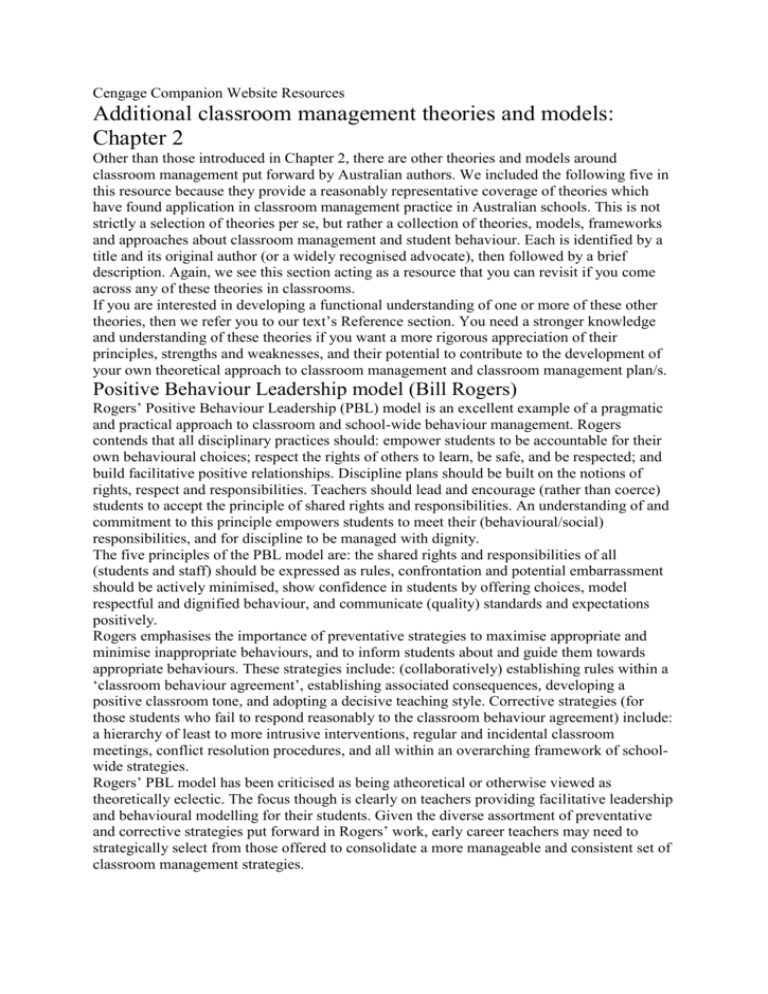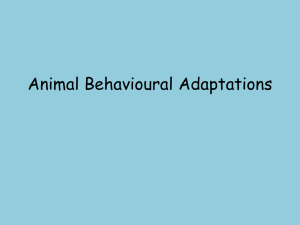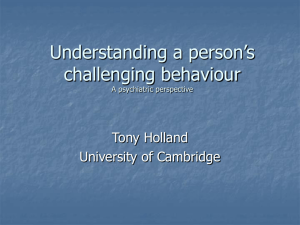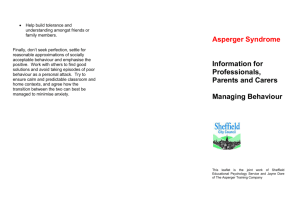0170233227_393772
advertisement

Cengage Companion Website Resources Additional classroom management theories and models: Chapter 2 Other than those introduced in Chapter 2, there are other theories and models around classroom management put forward by Australian authors. We included the following five in this resource because they provide a reasonably representative coverage of theories which have found application in classroom management practice in Australian schools. This is not strictly a selection of theories per se, but rather a collection of theories, models, frameworks and approaches about classroom management and student behaviour. Each is identified by a title and its original author (or a widely recognised advocate), then followed by a brief description. Again, we see this section acting as a resource that you can revisit if you come across any of these theories in classrooms. If you are interested in developing a functional understanding of one or more of these other theories, then we refer you to our text’s Reference section. You need a stronger knowledge and understanding of these theories if you want a more rigorous appreciation of their principles, strengths and weaknesses, and their potential to contribute to the development of your own theoretical approach to classroom management and classroom management plan/s. Positive Behaviour Leadership model (Bill Rogers) Rogers’ Positive Behaviour Leadership (PBL) model is an excellent example of a pragmatic and practical approach to classroom and school-wide behaviour management. Rogers contends that all disciplinary practices should: empower students to be accountable for their own behavioural choices; respect the rights of others to learn, be safe, and be respected; and build facilitative positive relationships. Discipline plans should be built on the notions of rights, respect and responsibilities. Teachers should lead and encourage (rather than coerce) students to accept the principle of shared rights and responsibilities. An understanding of and commitment to this principle empowers students to meet their (behavioural/social) responsibilities, and for discipline to be managed with dignity. The five principles of the PBL model are: the shared rights and responsibilities of all (students and staff) should be expressed as rules, confrontation and potential embarrassment should be actively minimised, show confidence in students by offering choices, model respectful and dignified behaviour, and communicate (quality) standards and expectations positively. Rogers emphasises the importance of preventative strategies to maximise appropriate and minimise inappropriate behaviours, and to inform students about and guide them towards appropriate behaviours. These strategies include: (collaboratively) establishing rules within a ‘classroom behaviour agreement’, establishing associated consequences, developing a positive classroom tone, and adopting a decisive teaching style. Corrective strategies (for those students who fail to respond reasonably to the classroom behaviour agreement) include: a hierarchy of least to more intrusive interventions, regular and incidental classroom meetings, conflict resolution procedures, and all within an overarching framework of schoolwide strategies. Rogers’ PBL model has been criticised as being atheoretical or otherwise viewed as theoretically eclectic. The focus though is clearly on teachers providing facilitative leadership and behavioural modelling for their students. Given the diverse assortment of preventative and corrective strategies put forward in Rogers’ work, early career teachers may need to strategically select from those offered to consolidate a more manageable and consistent set of classroom management strategies. Overall though, Roger’s PBL model (and his other work in the area of classroom and school management and working with students with challenging behaviours) is widely supported and implemented in Australian schools and educational systems. Developmental Management Approach (Ramon Lewis) The Developmental Management Approach (DMA) is an excellent example of a (research) evidence-based approach to managing classroom behaviour. Lewis explains that the increasing number of students who challenge teachers do so because of changing community values and standards around authority. This approach focuses on responding to inappropriate behaviours in the context of school (community) values, and the critical role of classroom interactions in the development of appropriate behaviours. Lewis is particularly concerned with Australian teachers’ increasing aggression towards misbehaving students, and sets out his DMA as one way of improving inappropriate student behaviours and classroom management by responding better to students’ individual needs. Lewis notes that a positive and productive classroom environment is only possible if effective classroom management prevails. Teachers want and need (evidence-based) effective, justifiable techniques for producing behaviour change and preventing inappropriate behaviours. The DMA identifies students in four categories to which Lewis has assigned specific response strategies to elicit appropriate behaviour. These are: Category A students, who constitute the majority, who generally respond appropriately to curriculum and instructional demands and require only verbal and non-verbal ‘hinting’ to elicit appropriate behaviour/s; Category B students, who are occasionally distracting and distracted, respond to rewarding appropriate behaviour and the class as a whole, and require more assertive use of consequences for inappropriate behaviour; Category C students whose behaviours warrant occasional isolation and follow-up individual discussions; and Category D students who frequently and repeatedly misbehave and require ‘instructional’ and ‘therapeutic’ responses. (An important presumption here is that students are in Category A unless consistent evidence indicates otherwise.) Explicit in the DMA is the necessity for an ongoing collaborative system of teacher support, including confidential individual support and school-wide support procedures and facilities. Lewis’s DMA stands out as a well-researched and evidence-based good practice in classroom management and for managing students with more challenging behaviours. Balance Model (Christine Richmond) Richmond’s elegantly simple Balance Model draws eclectically on a range of approaches to (or ‘styles’ of) classroom management. Richmond posits behaviour management as intentionally communicating with students to influence them to engage with their learning, and emphasises the critical importance of: being organised, being familiar with one’s own behaviour management style, clarifying your expectations to students, acknowledging strengths and correcting mistakes, working with challenging students, and being ‘openminded’ about the nature and motivations for student (mis)behaviours. The Balance Model is premised on the assertion that behaviour management practices must precipitate a reasonable balance between time spent on management and time spent on academic learning; that is, teaching deteriorates into ‘minding’ when behaviour practices are unable to effect this balance. Richmond contends that no behaviour management approach or style is better than another; rather that learning deteriorates to minding when any approach and its associated practices are ineffective. The Balance Model advises teachers to strike a facilitative and strategic balance between strategies used: to teach behavioural expectations, to acknowledge appropriate behaviours, and to correct inappropriate behaviours. Success lies in maintaining balance and, when necessary, recognising (potential) imbalances and correcting these. Richmond concludes that good teachers: clarify their expectations, give acknowledging feedback and use graded correction strategies – in balanced measures, and plan for (possible) individual interventions while building positive relationships with all their students. On the other hand, good teachers do not: take misbehaviour personally, react emotionally, compete with students for power or control, ask students to explain the reasons for their misbehaviours, blame outside factors for the student’s misbehaviours, send difficult students away to others to get ‘fixed’, or rely on commonsense! Supportive School Classroom Environment model (Peter Miles) Miles has cleverly identified common elements of school discipline principles and policies from various Australian education systems to bring together his Supportive School Classroom Environment (SSCE) model. He views behaviour as a skill which must be taught and the primary factors precipitating inappropriate or problem behaviour as medical, emotional, environmental, organisational and relational – with medical and emotional being the most prevalent. Behaviour management then is about teachers understanding and managing their own behavioural reasoning and responses, but significantly guided by their school policy and procedures. Miles posits that most teachers adopt eclectic theoretical and practical approaches to behaviour management but he emphasises the critical need to have a guiding philosophy to underpin a classroom (behaviour) management plan. The SSCE model is about the graded provision of support in a facilitative learning environment. The model identifies three ‘stages of intervention’(positive/preventative, supportive/problem-solving, and responsive/retrieval) and three ‘components’ (or foci) for action (curriculum, interpersonal relationships and organisation). Most students respond reasonably to preventative actions, some (maybe one in six) may need problem-solving actions, and a few (maybe one in 20) would need retrieval actions. Intervention designs should only move from least intrusive to more intrusive as necessary and must include a balance of all three components with a clear emphasis on improving relationships between teachers and students. Social skill development, argues Miles, is central to this relationship building. All interventions should be developed within the rubric of each teacher’s overall classroom behaviour management plan, which should include acknowledgement, correction, crisis, restitution and support plan components, and be endorsed at school executive level. Interventions should only move from being least intrusive (and least resistant to change) through to most intrusive (and most resistant to change) if necessary, so the focus should commence with changes to the physical environment first, then task requirements, social interactions and through to the student him/herself if warranted. For the most challenging individual students, Miles advocates the use of the Case Management Model with decision making duly informed by collaborative consultation. Solution-Focused Approach (Louise Porter) The Solution-Focused Approach is a unique, humanistic approach to counselling individual (but potentially class groups of) students encountering behaviour problems. Its roots are in Systems Theory which posits that individuals who are in frequent contact will unavoidably influence each other. In the classroom, this means that the locus of problem behaviour lies between the teacher and the student (and possibly other students) – not just within the individual student – so it is the nature of the interaction which must change. This essentially puts the initial onus of change on the teacher. Solution-focused theory differs significantly from most other individualist theories. It focuses on interactions rather than individuals, looks to finding solutions rather than looking for problems in the past, and seeks solutions built around people’s perceptions, rather than ‘expert’ answers from without. The premise that young people are the ‘experts’ in deconstructing and solving (with guidance) their own problems is clearly aligned with constructivist theory. The reoccurrence of problems suggests that relationships between people involved are caught in a self-sustaining cycle of discord. Previous attempts to solve the problem issue have failed. The Solution-Focused Approach empowers participants to look for strengths, capabilities and resources within themselves and the environment for selfgenerated solutions. Problem-solving discussions can be incidental or formally scheduled but prerequisite to any potential success is the proactive engagement of the student/s – so motivating the students to be involved is essential. There is a specific sequence of seven phases involved in this approach to counselling students. These are not so much a rigid linear sequence as the dialogue is quite ‘driven’ by the engagement and responses put by the student/s. This approach does require training, experience and expertise to facilitate success, and you are strongly encouraged to read further about this approach if it aligns with your philosophy of learning and teaching, and inspires your interest. Further classroom management theories and models: Chapter 2 This section very briefly describes an eclectic selection of 10 further theories and models around classroom management which have found application in schools in Australia. Most of these are variously comparable to those already presented but reading about these might give you additional insight into the principles underpinning similar theories and how they have been adapted and applied in practice. Understanding Classroom Discipline (Maurice Balson – Australia) Maurice Balson extended Dreikurs’ psychoeducational theories into a comprehensive approach to classroom discipline. On the premise that people’s basic need to belong was paramount, Balson sought to assist teachers to identify the goals, purposes and motivations for student (mis)behaviours. Other key principles include: teachers need to accept that many classroom misbehaviours arise because they do not have an adequate psychological understanding of these; children will (ultimately) use any means to achieve belonging and social place, so teachers must focus on changing the beliefs that lead to the emotions that lead to these (mis)behaviours; competitive classroom/school cultures and practices are counterproductive so the development of democratic values and practices, collaborative learning practices and student self-discipline must be central to the educative process. Kounin Model (Jacob Kounin) Kounin is widely regarded as one of the most influential classroom management theorists. His research focused on identifying key teacher behaviours which maximised student on-task time. These key behaviours include, for example, ‘with-it-ness’, which is an ability to know just what students are doing around the classroom (and for students to be aware of this); the ‘ripple effect’, when the way a teacher intervenes with an individual misbehaving student is similarly influential on others; ‘group management’, which is the ability of a teacher to capture and maintain class engagement such as attention and concentration; ‘avoiding satiation’, strategies teachers use to maintain interest and challenge through variation and difference with respect to content, pedagogy and/or assessment; and ‘movement management’, lesson pacing, momentum and transition. Kounin particularly emphasised the importance of this last group of behaviours. Positive Behavioural Intervention and Supports (George Sugai & Associates) (School-wide) Positive Behavioural Intervention and Supports (PBIS) is an increasingly popular and widely adopted approach to classroom and school-wide student discipline. The main premise is that ‘efforts should be focused on fixing problem contexts and not problem behaviours’ – changing behavioural expectations, not just behaviours. It is promoted as an ‘evidence-based decision-making framework for improving academic and behaviour outcomes for all students’. PBIS is characterised by data-based decision making and measurable (academic and behavioural) outcomes at the primary (whole-school), secondary (classroom) and tertiary (individual) levels. PBIS focuses on teaching pro-social skills and behaviours to all students, but emphasises the necessity to encompass action in the school, family and community domains. Applied behaviour analysis, normalisation and personcentred values provide the theoretical scaffold. Discipline through Influencing Group Behaviour (Fritz Redl & William Wattenberg) Although not widely adopted in the Australian context, the principles underlying the Redl and Wattenberg model are readily recognised in many school discipline policies and practices. Redl advocated: ‘permitting’, focusing on and being explicit about appropriate behaviours rather than misbehaviours; ‘tolerating’, not intervening about all unacceptable behaviours when some factors warrant tolerance; ‘intervening’, for some zero tolerance misbehaviours, but using a clear sequence of increasingly intrusive strategies; and ‘preventative planning’, changing overall classroom management plans and procedures if identifiable trends or patterns in misbehaviour were evidenced. The Redl Model is more aligned to behavioural theory. Classroom Management Training Program (Frederic Jones) This program applies more to primary school settings and focuses on the development of teacher skills. Jones argues that most teaching/learning time is lost to interventions for offtask students who are talking out of turn and/or getting out of seat. Jones lists many strategies/techniques for teachers, which he argues can be learned, and explains these under the headings of: effective use of body language; using incentives for motivation; and providing efficient individualised help during seatwork. The Jones model is more aligned to behavioural theory. Teacher Effectiveness Training (Thomas Gordon) Gordon believes, consistent with the philosophy of humanism, that (particularly older) students can solve their own problem and become self-controlling if appropriately supported (rather than coerced or punished). The focus of Teacher Effectiveness Training (TET) is that behaviours are needs-satisfying and should be accepted as such rather than judged as good or bad. Also, good communication prevents misbehaviour and promotes positive relationships and learning. The explicit focus of TET is to develop problem-solving strategies which are more corrective than preventative and also include school-wide strategies such as peer counselling and peer mediation. However, TET strategies are based on counselling students so they can be quite time consuming and require a sound background knowledge and understanding. TET is clearly aligned to psychoeducational theory. Systematic Training for Effective Teaching (Don Dinkmeyer & Associates) The emphasis in the Systematic Training for Effective Teaching (STET) program is on developing teachers’ communication skills. The program promotes the development of a democratic classroom where discipline is logical, choices are explicit and self-discipline is strongly encouraged. Key elements include: an emphasis on encouragement rather than praise; natural and logical consequences – not punishment; the systematic use of reflective listening procedures and ‘I’ messages to facilitate enhanced communication about thoughts, feelings and intentions; and the use of class meetings and problem-solving conferences (for more challenging students) to review classroom management plans and practices and promote positive, collaborative problem solving. STET complements and builds upon Thomas Gordon’s Teacher Effectiveness Training program. STET is more aligned to psychoeducational and cognitive behavioural theory. Stop-Think-Do (Lindy Peterson – Australia) Originally designed by Peterson as a social skills training intervention program for children and young people with behaviour difficulties, Stop-Think-Do has developed over many years into a very popular and successful, evidence-based (classroom and school-wide) preventative behaviour management program for primary and high school students. It also continues to be used as a remedial social skills program for smaller groups of children and young people, including those with more problematic behaviours. Stop-Think-Do has a cognitive behavioural theory base and focuses on assisting students to develop (social/behavioural) problem-solving skills over a series of lessons. The program outcomes are enhanced when school staff and parents are involved in a whole-school approach. The program is based around the simple metaphor of coloured streetlights ‘indicating’ stages to be taught in the problem-solving and decision-making processes. Responsible Thinking Process model (Ed Ford) The Responsible Thinking Process (RTP) model, grounded in William Powers’ Perceptual Control Theory, aims to empower teachers to use the principles of Perceptual Control Theory to specifically develop their disciplinary practices to support and teach students to become self-responsible – in the classroom and across the school. The RTP model provides specific detailed processes to accomplish this. Preventative practices focus on the sharing of (teacher and student) quality time and the establishment of quality caring relationships. Corrective strategies include scripted teacher–student engagements and student-negotiated conflict resolution engagements at a micro level, engagement of an Intervention Team and due processes, and time-out/re-engagement due processes. One strength of the RTP model is its comprehensive and consistent school-wide approach to developing student self-control and self-management. Pain Model (Patrick Connor – Australia) The Pain Model of Patrick Connor and his associates, although originally intended for use with highly at-risk students, has considerable potential to find wider application in Australian schools – particularly in a preventative context. The underlying principles are to be sensitive to others’ feelings, beliefs and needs and to value them, and to build positive relationships, but within the context of a democratic school milieu. If teachers and students can develop stronger ‘sensitivities’ like these it is probable that more interpersonal conflicts can be avoided or minimised. This will require schools and teachers to become more sensitive to students’ ‘pain’ and to engage more with parents and others in students’ potential support networks. This model is resource intensive – both in terms of teacher time and expertise – but many would argue that students ‘in pain’ – especially those at high risk of abuse and leaving school, are worthy of more intensive intervention. It does, though, take a lot of time, energy and dedication to work to relieve pain and calm a distressed student, re-social skill them, reconstruct their self-esteem, and engage parents and other professionals. This model which seeks to make school a ‘welcoming’ place where student wellbeing is the focus of school welfare policy and practices, has obvious challenges and benefits.






